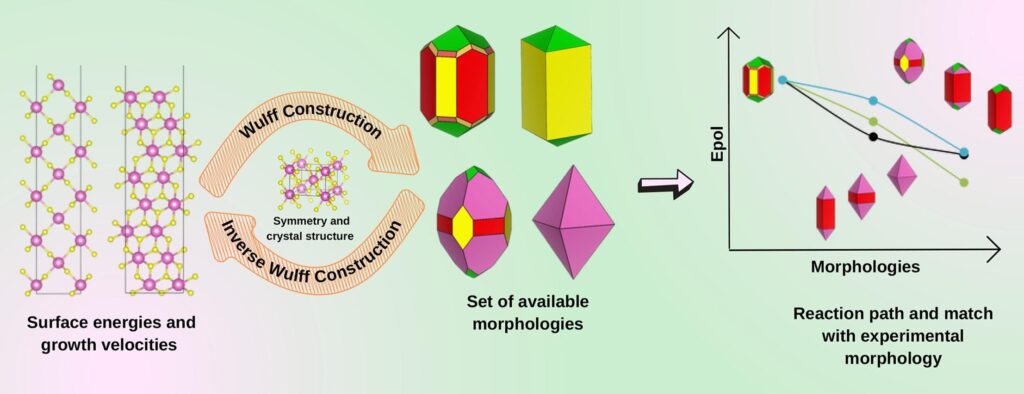
Um grupo de pesquisadores do Centro de Desenvolvimento de Materiais Funcionais (CDMF) publicou recentemente um estudo que ressalta a importância das alterações na morfologia para modular as propriedades e aplicações do dióxido de estanho (SnO2) utilizando cálculos de superfície associados à construção de Wulff, método aplicado para determinar a forma de equilíbrio de um cristal.
A busca por diretrizes para melhorar a atividade química e a estabilidade estrutural dos materiais é constante. Amanda F. Gouveia, primeira autora do estudo e pesquisadora vinculada ao CDMF, conta que por meio desta investigação foi possível propor um caminho da reação ao longo do processo de síntese, em que conecta diferentes morfologias dentro do mapa de morfologias. “Tal achado nos dá um norte para melhor entender e explicar as propriedades dos materiais. Além disso, essa ferramenta teórica pode ser utilizada pelos pesquisadores experimentais, uma vez que podem utilizar o microscópio de varredura e encontrar a mesma morfologia experimental”, explicou. Ela contou também que cada material pode apresentar diferentes morfologias, compostas por diferentes superfícies com diferentes agrupamentos de átomos, resultando em uma densidade eletrônica distinta em cada cristal.
No processo de investigação, o grupo utilizou a simulação mecânica-quântica para modular as superfícies e, posteriormente, as morfologias do material, construindo um mapa com as morfologias disponíveis por meio da utilização da construção de Wulff . A partir deste novo desenvolvimento, exposto no artigo “The hinge morphology of SnO2 as multifunctional semiconductor: what we can learn from simulations, theory, and experiments”, as propriedades dos materiais podem ser melhor entendidas e a ciência pode avançar mais rapidamente.
O trabalho, publicado na revista Applied Surface Science, contou também com a colaboração dos pesquisadores Celso M. Aldao, Miguel A. Ponce, Edson R. Leite, Elson Longo e Juan Andrés.
Como continuação da linha de pesquisa, foi publicado recentemente no periódico Nanomaterials o artigo “Back to the Basics: Probing the Role of Surfaces in the Experimentally Observed Morphological Evolution of ZnO”. No trabalho, os pesquisadores também conseguiram predizer o mecanismo de crescimento do cristal por meio do cálculo da energia relativa entre as suas superfícies. São autores deste estudo: Amanda F. Gouveia, Samantha C. S. Lemos, Edson R. Leite, Elson Longo e Juan Andrés.
The hinge morphology of SnO2 as multifunctional semiconductor: What we can learn from simulations, theory, and experiments

Abstract: Our interaction with materials occurs through their surfaces whose properties are strongly dependent on morphology, structure, and atomic arrangement. Unfortunately, obtaining a detailed correlation between the surface morphology with its properties is not straightforward. SnO2 is a multifunctional semiconductor ceramic that is exploited in several technological devices from sensor to energy storage, water splitting, and solar to fuel photocatalysis. This work focused on the structural, energetic, and electronic properties of low and high index surfaces of SnO2 semiconductor and assessed the morphology-dependent process via first-principles calculations, at the density functional theory level. Importantly, our explicitly dynamic approach elucidates the atomic arrangements and stability of the exposed surfaces to provide a close match between experimental field emission scanning electron microscopy images and computational simulation. These findings can potentially set a foundation for establishing synthesis techniques for drive the morphology evolution through the control of temperature/pressure, and/or based on surface interactions of the selective adsorption of solvents/surfactants.
Author(s): Amanda F. Gouveia, Celso M. Aldao, Miguel A. Ponce, Edson R. Leite, Elson Longo e Juan Andrés.
Applied Surface Science
Available online 3 March 2023
Link: https://www.sciencedirect.com/science/article/pii/S0169433223005809
Back to the Basics: Probing the Role of Surfaces in the Experimentally Observed Morphological Evolution of ZnO

Abstract: Although the physics and chemistry of materials are driven by exposed surfaces in the morphology, they are fleeting, making them inherently challenging to study experimentally. The rational design of their morphology and delivery in a synthesis process remains complex because of the numerous kinetic parameters that involve the effective shocks of atoms or clusters, which end up leading to the formation of different morphologies. Herein, we combined functional density theory calculations of the surface energies of ZnO and the Wulff construction to develop a simple computational model capable of predicting its available morphologies in an attempt to guide the search for images obtained by field-emission scanning electron microscopy (FE-SEM). The figures in this morphology map agree with the experimental FE-SEM images. The mechanism of this computational model is as follows: when the model is used, a reaction pathway is designed to find a given morphology and the ideal step height in the whole morphology map in the practical experiment. This concept article provides a practical tool to understand, at the atomic level, the routes for the morphological evolution observed in experiments as well as their correlation with changes in the properties of materials based solely on theoretical calculations. The findings presented herein not only explain the occurrence of changes during the synthesis (with targeted reaction characteristics that underpin an essential structure–function relationship) but also offer deep insights into how to enhance the efficiency of other metal-oxide-based materials via matching.
Author(s): Amanda F. Gouveia, Samantha C. S. Lemos, Edson R. Leite, Elson Longo e Juan Andrés.
Nanomaterials
Available online 8 March 2023
Link: https://www.mdpi.com/2079-4991/13/6/978/html
CDMF
O CDMF é um dos Centros de Pesquisa, Inovação e Difusão (Cepids) apoiados pela Fundação de Amparo à Pesquisa do Estado de São Paulo (Fapesp), e recebe também investimento do Conselho Nacional de Desenvolvimento Científico e Tecnológico (CNPq), a partir do Instituto Nacional de Ciência e Tecnologia dos Materiais em Nanotecnologia (INCTMN).

